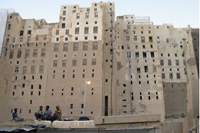
International award for Yemeni Islamic architecture [Archives:2007/1083/Last Page]
September 6 2007
 |
 |
Yemen received two of nine Aga Khan Foundation (AKF)'s awards handed in Kuala Lumpur on Tuesday Sept. 4, 2007. Minister of Culture Dr. Mohammed Al-Muflihi received the two awards, on behalf of Yemen. The first award honors the historic Al-Ameriya Complex in the town of Rada', and the second recognizes the historic town of Shibam, Hadhramout province, whose architectural characteristics are still intact.
The Aga Khan Award was established in 1977. It is one of the most renowned international architectural awards. It is presented once every three years to projects of outstanding achievement in terms of design, technical innovation, service to society, and / or environmental sensitivity.
Al-Ameriya Madrasa
This historic landmark is significant as a wonderful and rare model of Islamic Yemeni architecture for it incorporates all Islamic decorative styles. This architectural masterpiece displays the characteristics of eastern and western Islamic decoration. It is rare to find such diversity in one place. It attracted governmental, nongovernmental and even international attention. The government of the Netherlands participated in the restoration efforts of this historic landmark and provided financial and media support.
The Dutch participated in financing the woodwork and preparing the ground floor, making it into a museum showing the different stages of restoration right from the miserable initial status of the building. In association with the Social Fund for Development, the Dutch also financed, cleaned and fitted color decorations.
The work was carried out by an Italian expert team, Yemeni Antiquities Authority specialists, and a number of Yemeni craftsmen from the area of Rada'.
According to the AKF's Award Committee, Al-Ameriya deserves this award for its architectural distinction as the restoration project involved a large number of craftsmen and archeologists and required the training of numerous laborers. These skilled people will play a role in the future in protecting and maintaining various architectural and historic sites in Yemen and the rest of the Muslim World and will contribute to the conservation of the human civilization heritage.
The restoration endeavor preserved the original remarkable spirit of Al-Ameriya in terms of design, architecture, decorations and construction raw material. Moreover, it resurrected old handicrafts and made use of the same raw materials as used in originally building Al-Ameriya under the reign of Sultan Amer bin Abdul-Wahab of the Tahirite Dynasty in 1504 A.D. (910 After Hejra). No modern-era materials have been used in the restoration process that was masterfully faithful to the original designs and contents of Al-Ameriya Complex. Al-Ameriya Madrasa and Mosque (Al-Ameriya Complex) in the town of Rada' have recently been nominated for international awards, most important of which is the Aga Khan Award for Architecture which Yemen received on Tuesday Sept 4, 2007.
Historic town of Shibam
Among the recipients of the 2007 Award is the Yemeni-German Shibam Urban Development Project. The project is a technical cooperation initiative aimed at rehabilitating the historic city of Shibam through an integrative approach that combines heritage conservation strategies with economic development for the local community.
In its verdict, the Jury highlighted “that the Shibam Urban Development Project has approached the city as a living community rather than a historical artifact frozen in time”.
Since the year 2000 the Federal Government of Germany has provided funds in support of the efforts by the Yemeni Ministry of Culture to preserve, upgrade and develop the world heritage site of the historic city of Shibam. The German development agencies GTZ and DED implemented the project in collaboration with the General Organization for the Preservation of Historic Cities in Yemen (GOPHCY). The technical cooperation program has worked with community based NGO's, local government and the residents of the city to improve living conditions, restore historic houses, develop economic activities, and establish sound urban management practices. The Social Fund for Development of Yemen provided additional support.
To date, more than half of the spectacular 6-9 storey mud buildings of the city have been
upgraded and rehabilitated through a flexible subsidy scheme that provides local residents with incentives to restore their historic homes. Traditional skills for mud construction created a large demand for labor and the ranks of mud builders were organized through the efforts of a Mud Architecture NGO that insured the ancient knowledge of the trade are adequately being passed on to new apprentices.
Furthermore, Agricultural projects in the oasis around Shibam rehabilitated the historic spate irrigation system. Literacy programs and educational support for women improved women's access to income generating activities. Craftspeople were trained to develop their products and to capitalize on tourist revenue potentials. The Local Government developed solid waste programs and infrastructure projects. Combined with the improvement of the historic houses,
These initiatives established “a viable alternative to the mundane mass architecture found in many economically depressed parts of the world”, as stated by the Jury.
——
[archive-e:1083-v:15-y:2007-d:2007-09-06-p:lastpage]


